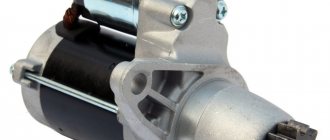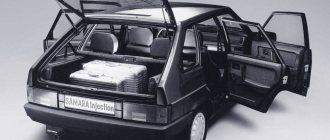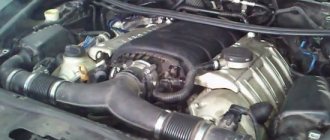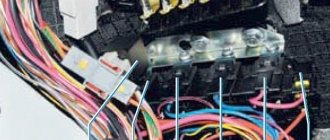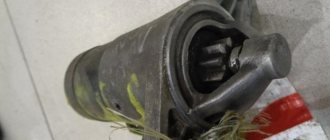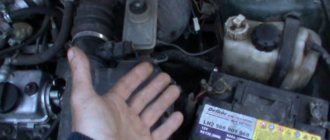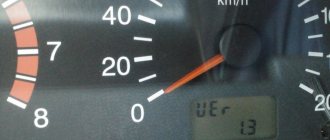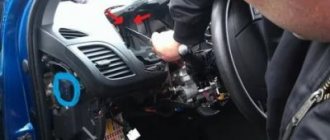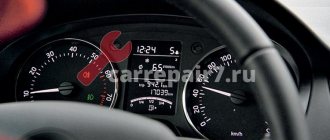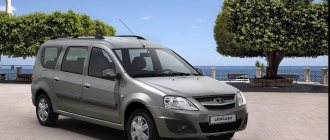Calling a tow truck or towing a car when it stalls on the road is usually too expensive. It will not be possible to carry out diagnostics on the road without special equipment. In addition, in most cases, the reasons that the Opel Astra does not start do not lie in an electronics failure.
The reasons for the complete lack of response of the power unit to attempts to start it can be very different. First, you need to determine the original source of this problem, after which you can figure out what can be done next.
Engine compartment of Opel Astra H with Z18XER engine (sedan)
Frightening reality
Sometimes a motorist is faced with the fact that the Opel Astra does not start, the starter does not turn. What to do in such a situation? Some are starting to panic, and for good reason. Towing or using a tow truck is not a very profitable idea if the car is located far from service centers. It is impossible to diagnose a “swallow” and decode errors while being hundreds of kilometers from the city: electronic mechanisms do not provide this opportunity. In most cases, the reasons for this behavior turn out to be much more serious.
The starter doesn't turn over
If the starter does not turn, then you should find out whether there is current in the electrical network. If, after turning the key, none of the lamps on the dashboard light up, then everything is very simple - there is no electricity. The presence of current in the battery can be checked using a conventional tester. If the battery is discharged, it must be replaced with a good one. Afterwards, when the battery is working, you should check the reliability of the terminal connections to it.
By the way, if the battery is already dying, then during numerous stops while driving in the city, it is better not to turn off the Z18XER at all. Nothing drains the battery more than frequently cranking the starter.
Next you need to check the fuses. Their placement on various Opel trim levels: Astra H, Astra J, Astra G Astra F, with 1.3, 1.4, 1.6, 1.7 and 1.8 liter engines, GTC or OPC versions, with automatic or manual transmissions may vary. It's best to start with the fuses located under the hood.
If an anti-theft system with the ability to block the internal combustion engine is installed on the car, it may be the cause of all the troubles.
The next thing you need to look at is the contact group of the ignition switch. Usually, you can get to it after removing the steering column cover. In general, there should be no suspicious sounds when turning the key. The ignition switch is not the most expensive part, and if something is crunching inside it, then the best solution would be to replace the part.
- If there is current, but it is quiet under the hood, the starter may be the culprit. Inspecting it on the road is quite problematic. Most often, the relay in the starter fails. It happens that tapping on the relay body is enough to make the starter work.
- If the relay clicks but the starter still does not turn, there may not be enough voltage in the system or the relay may have failed. In this case, it is unlikely that you can do anything with the help of improvised means; you need a load plug or a working battery.
#3 Ivan93
- City: Volgograd
- Gender: Man
Yes, I searched all over Google and there are no similar topics, if I had found it, I would not have created a topic.
What does the situation look like in practice?
You can draw a conclusion about the presence of problems when the Opel Astra does not start, the starter does not spin, based on several characteristic factors:
- The car does not respond to the owner's actions.
- Poor cold starting is observed.
- “When it’s hot,” a similar reaction occurs.
It is necessary to understand in more detail the problem of why the Opel Astra does not start, the starter does not turn, and find a way to fix it.
Fuel
First of all, when the car does not start, you should make sure whether there is gasoline or diesel in the tank. Also, if the Opel Astra H starts and stalls, then the fuel may have run out. You should not try to start the car in such a situation, as this could damage the fuel pump.
If there is too much water in petrol or diesel, the Astra may also have trouble starting.
If the car has been parked for more than 3 months, gasoline breaks down into fractions, its lighter parts settle down, and the lightest and most flammable parts rise up, gradually evaporating. Therefore, after parking for a long time, the Opel Astra often does not start and stalls. To avoid this, it is recommended to drain the fuel before parking for a long time, or periodically start the engine. There are also special fuel additives that prevent the breakdown of gasoline.
This problem is not typical for a diesel engine, however, after a long period of parking, bacteria and fungi can begin to develop in the tank. Especially if Astra is operated in a warm, humid climate. As a result, launching will be extremely difficult. The cure for this problem is the same as for gasoline - periodically start the engine, drain the diesel, or use additives.
Also, the Opel Astra H running on diesel is characterized by thickening of the fuel in the tank. Diesel thickens at lower temperatures than gasoline. To avoid this, you should fill in special winter fuel in cold weather. There are also special diesel additives that provide the optimal freezing point.
Briefly about the reason
In this issue, the current cause is a dead battery. A non-functioning battery is directly related to a defective flywheel. Before carrying out diagnostic procedures in the unit, it is necessary to check the condition of the battery structure. There is a high probability of urgent recharging or buying a new one.
The second factor affecting the operation of the power unit system is a malfunction of the alarm system. When wondering why the Opel Astra does not start, the starter does not turn, the reasons can be found in the blocking of the starter circuit. This occurs when voltage parameters are 10 V or below this mark. It is important to keep the battery charge level under control and charge it periodically. Let’s say the device is in order, what then?
Problems specific to diesel Astras
- First of all, these include problems with the fuel system. Low-quality diesel fuel significantly complicates the life of many Astra owners with a diesel unit. Diesel fuel is divided into winter and summer - this is also important to remember. Dirt contained in large quantities in diesel fuel also creates problems over time.
- Violation of the tightness of the fuel system also leads to numerous problems. Low-quality fuel greatly shortens the life of the injectors.
- A malfunction of the fuel injection pump immediately leads to a malfunction of the fuel supply system and problems with starting. To measure the pressure on the Opel Astra H ramp there is a special fitting to which a pressure gauge can be connected.
- The rather high cost of repairing diesel power units is the flip side of their supposed cost-effectiveness in maintenance. Most of all, these motors do not like downtime.
We can stop there. Experienced car owners have probably noticed the superficiality of the above tips. This is mainly done in order not to provoke readers to carry out independent treatment of their cars, since this usually does not lead to good.
The car refuses to start
If there are no problems with the battery, if the Opel Astra does not start, the starter does not turn, the causes of the malfunction will have to be looked for elsewhere. The engine has stopped functioning, what should I do? Auto mechanics give good advice in this case:
- It is necessary to check the presence of electric current in the on-board network. It's easy to find out: turn the key in the ignition and look at the indicator arrows. In the absence of their “signs of life,” there is no current. A multimeter comes into the diagnostic business, checking whether there is current in the battery. Without a meter, you can use a carrying lamp, synchronizing it with the battery contacts.
- Without finding any breakdowns in this segment, the search for the reason why the Opel Astra does not start and the starter does not turn (it is not so easy to find a solution to the problem) will continue. You can check the connection of the battery terminals. If they are connected incorrectly, the relay blocks the functionality of the electrical circuits.
- You should look at the fuses, starting with the interior fuses and ending with those located under the hood. Burnt out options need to be replaced. The difficulty lies in the different locations of fuses on models of the automaker from Germany: it’s good to have a diagram on hand, keep a diagram in the glove compartment.
- The culprit of the troubles may be a non-standard anti-theft system. Only the specialists who were involved in its installation will be able to suggest ways out of the situation. The best solution is to try to turn it off.
- The ignition switch group is acting up. By removing the steering column cover, the driver can easily access this structure. Most often, its fixation is based on a pair of screws coupled with a pin. The main thing here is to monitor the terminal connector: the tightness of its fastening is important. Crunches and clicks will indicate “illnesses” of the system. Using the electrical circuit, it is easier for the motorist to find the optimal solution, so it should always be in the glove compartment.
- There is current, the lights indicate serviceability, but the hood is silent. The reason why the Opel Astra does not start, the starter does not turn, is the unreliable fixation of the starter wires due to the failure of the electromagnet. At first, there are malfunctions in its operation, a barely perceptible knock is heard. There is no way you can delay servicing this device. The clicking of the solenoid relay, while the starter does not rotate, indicates a voltage shortage in the vehicle's electrical network or a malfunction of the relay. It is impossible to check the voltage indicator yourself, since a load plug is required. An alternative solution could be a working battery. This will help to finally remove suspicions or confirm the problem.
Opel Astra H won't start - let's find out point by point
Turn off the ignition (you can remove the key), turn on the turn signal in the direction you want to mark. The side lights on the required side of the vehicle are turned on. 2. The road to the house.
Turn off the ignition, remove the key, open the driver's door, and flash the high beam headlights.
We have 30 seconds to lock the car and move along the illuminated road. 3. Frequency of operation of the wipers.
We turn on the “windshield wipers” for one pass (switch to the bottom), maintain a pause that is necessary for the operation of the windshield wiper blades (interval from 2 to 15 seconds) and turn the switch to the first position (intermittent mode, one “step” to the top).
Another interesting option for the operation of Opel wipers is that if the windshield wiper blades are turned on, then when reverse gear is engaged, the rear window wiper is automatically turned on. To install the wipers in a vertical position
(for convenience when replacing or in winter), turn off the ignition (do not take out the key) and immediately press the wiper switch down (one pass), hold for 3-5 seconds. Release the switch when the wipers have reached the desired position on the windshield. 4. Error codes. (here is an explanation of the errors) If the car with a key lights up on the instrument panel, then the control unit has registered a malfunction in the operation of the car. You can read the error code in the following way; – simultaneously press the brake and gas pedals and do not release; – insert the key into the ignition and turn it until the indicator lights on the instrument panel turn on, but do not start; – we wait for the ECN inscription to appear where the car’s mileage is displayed.
| Error code |
The first four digits reflect the error code, the last two - the error value. If there are no errors, then zeros are displayed (see photo).
5. InSP or remaining mileage before maintenance.
To ensure timely vehicle maintenance, a graphical notification of upcoming technical inspection is provided. Violation of the maintenance deadlines entails instability of the components and assemblies of the vehicle. If the InSP message appears on your instrument panel, then it’s time to check the service booklet, which indicates the frequency of maintenance.
To reset the meter readings, you must do the following: – turn on the ignition (do not start the engine); – turn off the ignition; – press and hold the daily mileage reset button (the display will show the remaining km before the service); – without releasing the button, depress the brake pedal and hold it; – turn on the ignition (reset the readings, flashing InSP); – hold the button and the brake pedal until the flashing sign disappears; – release the brake pedal and button.
6. Test mode BC
To enable the BC test mode, you must do the following: – turn on the radio; – press the “Settings” button and hold it until the sound signal; – by pressing the “BC” button we scroll through the data screens.
| Testmode:Heater |
| Testmode: Dimming |
Input; Chart; LEDs – values change when the lights are turned on and the backlight brightness is adjusted.
To reset the meter readings, you must do the following: – turn on the ignition (do not start the engine); – turn off the ignition; – press and hold the daily mileage reset button (the display will show the remaining km before the service); – without releasing the button, depress the brake pedal and hold it; – turn on the ignition (reset the readings, flashing InSP); – hold the button and the brake pedal until the flashing sign disappears; – release the brake pedal and button.
Recommendations from auto mechanics
Often, in search of answers to a sore subject about why the Opel Astra does not start, the starter does not turn, fixing the problem comes down to checking the viscosity of the oil in the engine. A decrease in its level leads to a drop in compressors. There is a high probability that the lubricant will need to be replaced. A drop in compression in the cylinders causes a failure of the hydraulic compensators responsible for regulating valve clearances. Why is this even happening? Low quality of a product is not yet a special reason to worry. By changing the oil and changing the oil filter, the problem can be solved without going to a car repair shop for expensive debugging.
Another thing is that coolant and gasoline get into the oil. A forced check of this node will follow with the upcoming selection of a correction technique.
Specifications 1.4 Twinport
| Volume | 1364 cc cm |
| Power/torque | 90 horsepower / 125 Newton meters |
| Piston stroke | 80.6 mm |
| Environmental standards | EURO-4 |
| Supply system | Injector (an electric fuel pump is installed in the tank, plus a fine gasoline filter is used) |
| Crankcase cooling and ventilation | Liquid cooling, closed crankcase ventilation system (the cooling jacket is cast and surrounds the cylinders in the block) |
| Lubrication system volume | 3.5 l |
| Operating temperatures | 90 to 95° |
| Fuel | Gasoline AI-95 |
| Combined fuel consumption | From 5.9 to 6.6 liters per 100 km (depending on model) |
About the emergency start method
A broken auto starter is not a very serious reason to panic. It is not forbidden to immediately start the engine “directly”. How does this look on Lada 110?
- Neutral gear is engaged. The car is put on the handbrake.
- You need to turn on the ignition and open the hood.
- The air filter will need to be removed.
- The contact group chip is disconnected.
- Use a screwdriver or a piece of wire to short-circuit the flywheel terminals.
Now you can continue your journey. Repairing the starter system is far from an easy process. The technicians at the service station will carry out competent diagnostics, making sure that there is a problem before disassembling. They will be determined by several signs: the drive coupling along the shaft does not rotate well, the drive gear rotates against the direction of the anchor rotation. The operating traction relay clicks and the drive clutch moves forward. Otherwise, the element will need to be replaced. With the help of professionalism and skill of servicemen, the repair problem will be quickly solved.
Z14XEP design
The naturally aspirated gasoline engine is built on a cast-iron cylinder block with a diameter of 73.4 mm. The sixteen-valve cylinder head is made of aluminum, uses two camshafts and four valves for each cylinder. There is no need to adjust the valves thanks to hydraulic compensators. To drive the gas distribution mechanism, a chain is used, which, despite the manufacturer’s instructions, it is advisable to change at least once every 150 thousand km.
The main feature of the Z14XEP is the intake tract, which has variable geometry. This system is called Twinport, and is used by other automakers, but under a different name and with certain modifications. The introduction of Twinport together with EGR allowed engineers to minimize consumption (gasoline savings - 6%), reduce the amount of harmful emissions, improve the efficiency of the internal combustion engine and the knock resistance of the air-fuel mixture. What is an intake tract system that has variable geometry?
There are two intake ports for each cylinder, one of them is equipped with a damper. At increased loads, this damper opens, allowing the maximum amount of air to enter the cylinders. When the speed drops, the valves close. This promotes proper mixture formation at low loads.
To connect the dampers, a rod is used, and control is carried out by a vacuum regulator, which is controlled by the ECU.
Until 2006, the Z14XEP engine was additionally equipped with a rheostat sensor that monitors the position of the dampers and normalizes the functioning of the system.
Other features of the 1.4 Twinport include:
- Electronic gas pedal.
- BOSCH control unit ME7.6.1, ME7.6.2. It is better not to experiment with their interchangeability, as there may be problems with the firmware. About 80% of ECUs offered at disassembly sites are sold without CarPas, which means that their real cost is close to zero.
- A system that collects fuel vapor, which consists of an adsorber, a purge valve, and pipelines.
It is important to understand that Twinport is different from a system that changes the length of the intake manifold, since it directly affects the cross-section of the channel. This principle is the basis of mixture formation, which significantly distinguishes Twinport from CVCP, which is also used on Opel cars.
Installation of HBO
In order to save money, many owners of Opel with a Z14XEP engine decide to install gas equipment. The procedure has certain subtleties, which is associated with the Twinport system. It is important to insert the fittings correctly; setting up does not cause any difficulties.
It often uses fourth-generation gas equipment with a compact cylinder with a capacity of about 40 liters, which is installed instead of a spare tire. Consumption on gas, subject to correct settings, is only 1-2 liters more than on gasoline. This is an obvious saving, although the car is not particularly power-hungry anyway.
Typical breakdowns of 1.4 Twinport
1) Check Engine error caused by a malfunction of the sensor that monitors the position of the dampers. When connecting diagnostic equipment, it displays error P1113. The reasons lie in the breakdown of the sensor itself or incorrect operation of the damper drive mechanism. Less often, the dampers hang in one position, which is associated with contamination of the intake tract. It is easy for the owner to recognize the problem by characteristic dips when driving at low or high speeds. Often during repairs it is necessary to change the manifold assembly and clean the intake channels of deposits. If you turn off the Twinport system, the mixture formation will be disrupted, so this solution cannot be called rational.
2) Floating speed, the car stalls and accelerates poorly. The problem is presumably caused by a dirty EGR valve that needs to be cleaned or plugged.
3) A leaking sensor that monitors the oil pressure in the system. It is best to replace it with an original analogue.
4) Increased noise (characteristically the timing chain rattles, which stretches with a mileage of about 150 thousand km).
5) Leaking valve cover. To eliminate the defect, you need to change the gasket.
6) Failure of the oil pump, thermostat, ECU control unit. ECU failures manifest themselves in different ways. For example, in the Opel Corsa, this block influences the operation of the injectors in accordance with the current valve timing. They turn on every time the crankshaft makes a 720° turn. In dynamic operating mode, fuel is supplied asynchronously.
If the ECU breaks down, the functioning of the fuel supply system is disrupted, although other, no less serious defects also occur.
7) Increased oil consumption. According to the regulations, normal oil consumption should not exceed 0.6 liters per 1000 km. But these are maximum figures; if such an amount of oil is wasted, it is advisable to make a diagnosis. Perhaps switching to an oil of a different viscosity or from a different manufacturer will help reduce its consumption; sometimes decarbonization helps.
Tuning Z14XEP
Upgrading the 1.4 Twinport engine to improve technical characteristics is pointless. It is possible to plug the EGR, remove the catalyst, and reflash the ECU. This is irrational, as it will only give a power increase of 10–20 horsepower.
More can be achieved by regrinding the camshafts, installing a different intake manifold, and performing chip tuning (the average power increase fluctuates around 12%). It will be expensive and therefore financially unjustified. It’s better to immediately think about replacing the Z14XEP with a 1.8 XER with 140 horsepower.
